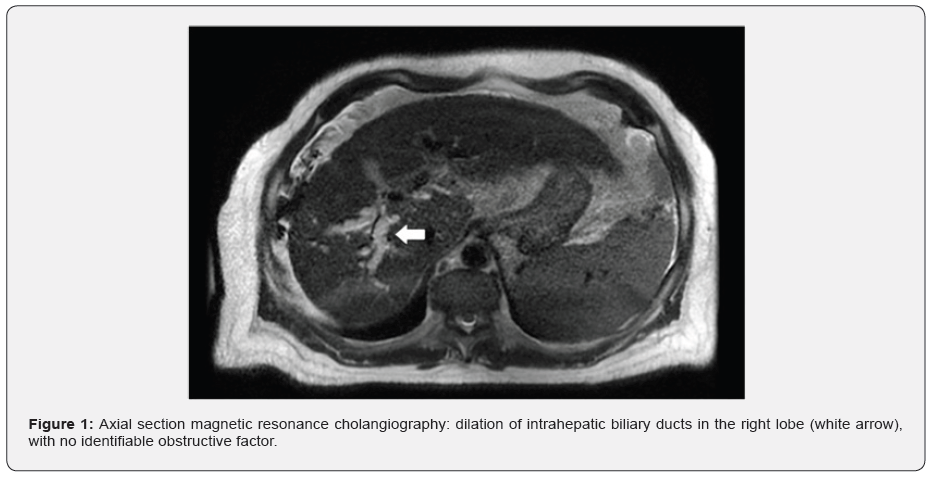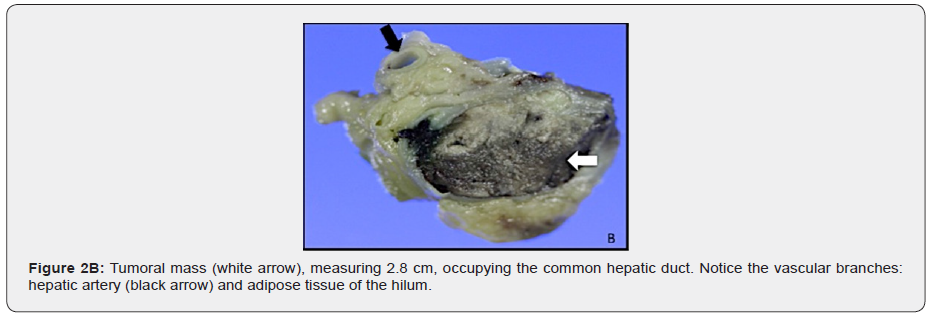Intraductal Hepatocellular Carcinoma Leading to Obstructive Jaundice
Raquel D Greca1*, Marlone Cunha-Silva1,3, Larissa BE Costa2, Tiago Sevá-Pereira1,3, Ilka FSF Boin3,4
1 Division of Gastroenterology (Gastrocentro), University of Campinas (Unicamp), Brazil
2 Department of Pathology, University of Campinas (Unicamp), Brazil
3 Unit of Liver Transplantation, Hospital de Clínicas, University of Campinas (Unicamp), Brazil
4 Department of Surgery, University of Campinas (Unicamp), Brazil
Submission:February 10, 2021;Published:February 25, 2021
*Corresponding author:Raquel Dias Greca, Division of Gastroenterology (Gastrocentro), University of Campinas Rua Carlos Chagas, 420. Cidade Universitaria / Campinas, São Paulo, Zip code 13083-878, Brazil
How to cite this article:Raquel D G, Marlone Cunha-S, Larissa BE C, Tiago Sevá-P, Ilka FSF B. Intraductal Hepatocellular Carcinoma Leading to Obstructive Jaundice. Adv Res Gastroentero Hepatol, 2021;16(4): 555941. DOI:10.19080/ARGH.2021.16.555941.
Keywords: Liver cancer; Bile duct obstruction; Liver transplantation; Cytokeratin 19; Jaundice
Case Description
A 48-year-old man with metabolic-dysfunction associated fatty liver cirrhosis was first on the transplant waitlist. Upon hospital admission, he complained of jaundice over the past month. Laboratory: total bilirubin 31.6 mg/dL (normal range <1.2); direct bilirubin 25.7 mg/dL (<0.2); alkaline phosphatase 200 U/L (<104); international normalized ratio 1.64 (<1.25). Serum alpha-fetoprotein was normal and all cultures were negative. Both ultrasound, tomography and magnetic resonance cholangiography (Figure 1) showed a biliary dilation of the right hepatic lobe, with no evidence of an obstructive factor. He had a normal enhanced tomography for hepatocellular carcinoma (HCC) surveillance (because of obesity) two months before. With no signs of infection, a transplantation was performed.

The explant analysis evidenced a moderately differentiated HCC measuring 3.0 x 2.5 x 2.5cm in the segment VIII (Figure 2A) with an intraductal biliary invasion (Figure 2B), and liver cirrhosis. No angiolymphatic spread was observed (Figure 3A). On immunohistochemistry, CK-7 and CD-56 marked the tumor but CK-19 was only expressed in the biliary epithelium (Figure 3B).



Obstructive jaundice as a first HCC clinical feature is uncommon (2%–8%) [1]. Some patients present liver failure or advanced tumors [2,3]. Intraductal biliary invasion of a respectable HCC is extremely rare [4,5]. In our case, biliary obstructive hepatopathy was present, related to the intraductal involvement of HCC— which led to MELD worsening and enabled a faster transplant.
In order to improve the assessment, physicians may prefer to treat biliary obstruction with endoscopic prostheses, since it remains a challenge to find out whether surgical resection or transplant would be more appropriate. Our patient had a favorable outcome and is still alive 21 months later.

Description of Financial Support or Competing Interests
The authors received no specific funding for this work. The authors have declared that no competing interests exist.
Description of Author’s Contributions
R.D.G. and M.C.S. contributed substantially to the conception and design of the study and drafting of manuscript. L.B.E.C. performed the histological examination of the liver and was a major contributor in writing the manuscript. T.S.P. and I.F.S.F.B. provided critical revision of the article and final approval of the version to be published.
Confirmation that Informed Patient Consent was Obtained for Publication of the Case Details
The study was approved by the hospital ethics committee at the University of Campinas (protocol number 28784120.4.0000.5404) and written informed consent was obtained from the patient.
References
- Van Dinter TG Jr, Schmidt JF, Tarnasky PR (2011) Obstructive jaundice caused by intraductal hepatocellular carcinoma. Clin Gastroenterol Hepatol 9(9): e94-e95.
- Qin LX, Tang ZY (2003) Hepatocellular carcinoma with obstructive jaundice: diagnosis, treatment and prognosis. World J Gastroenterol 9(3): 385-391.
- Lau WY, Leung JWC, Li, AKC (1990) Management of Hepatocellular Carcinoma Presenting as Obstructive Jaundice. Am J Surg 160(3): 280-282.
- Kojiro M, Kawabata K, Kawano Y, Shirai F, Takemoto N, et al. (1982) Hepatocellular carcinoma presenting as intrabile duct tumor growth: a clinicopathologic study of 24 cases. Cancer 49(10): 2144-2147.
- Bhattarai S, Graham RP, Sigel CS, Shi, J, Gonzalez RS, et al. (2019) Bile duct involvement by hepatocellular carcinoma: A rare occurrence and poor prognostic indicator in bile duct brushing samples. Cancer Cytopathol 127(11): 691-699.






























